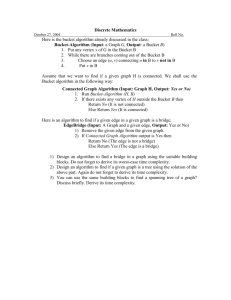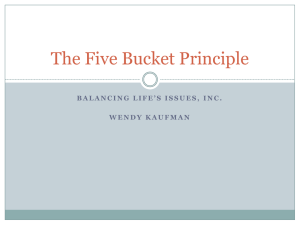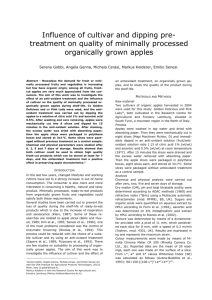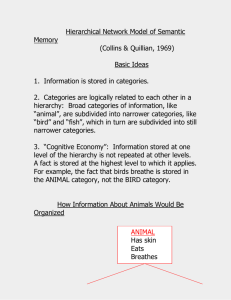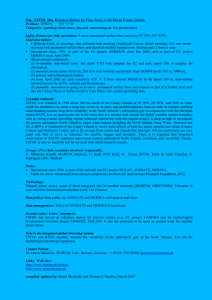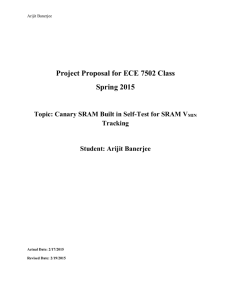each
advertisement
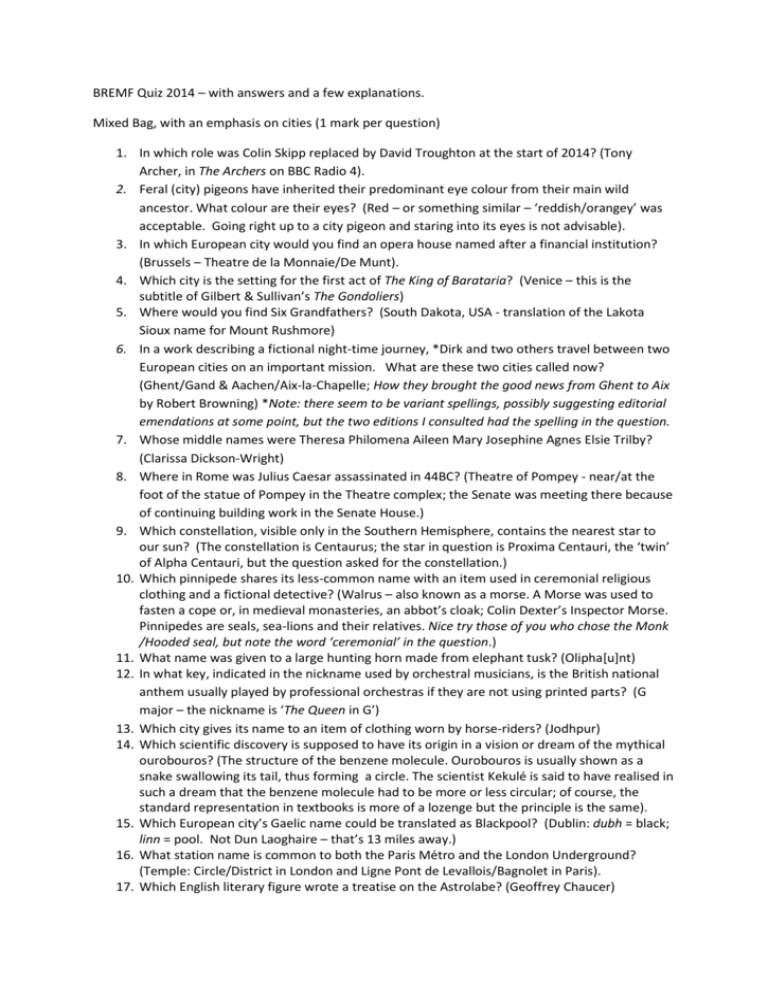
BREMF Quiz 2014 – with answers and a few explanations. Mixed Bag, with an emphasis on cities (1 mark per question) 1. In which role was Colin Skipp replaced by David Troughton at the start of 2014? (Tony Archer, in The Archers on BBC Radio 4). 2. Feral (city) pigeons have inherited their predominant eye colour from their main wild ancestor. What colour are their eyes? (Red – or something similar – ‘reddish/orangey’ was acceptable. Going right up to a city pigeon and staring into its eyes is not advisable). 3. In which European city would you find an opera house named after a financial institution? (Brussels – Theatre de la Monnaie/De Munt). 4. Which city is the setting for the first act of The King of Barataria? (Venice – this is the subtitle of Gilbert & Sullivan’s The Gondoliers) 5. Where would you find Six Grandfathers? (South Dakota, USA - translation of the Lakota Sioux name for Mount Rushmore) 6. In a work describing a fictional night-time journey, *Dirk and two others travel between two European cities on an important mission. What are these two cities called now? (Ghent/Gand & Aachen/Aix-la-Chapelle; How they brought the good news from Ghent to Aix by Robert Browning) *Note: there seem to be variant spellings, possibly suggesting editorial emendations at some point, but the two editions I consulted had the spelling in the question. 7. Whose middle names were Theresa Philomena Aileen Mary Josephine Agnes Elsie Trilby? (Clarissa Dickson-Wright) 8. Where in Rome was Julius Caesar assassinated in 44BC? (Theatre of Pompey - near/at the foot of the statue of Pompey in the Theatre complex; the Senate was meeting there because of continuing building work in the Senate House.) 9. Which constellation, visible only in the Southern Hemisphere, contains the nearest star to our sun? (The constellation is Centaurus; the star in question is Proxima Centauri, the ‘twin’ of Alpha Centauri, but the question asked for the constellation.) 10. Which pinnipede shares its less-common name with an item used in ceremonial religious clothing and a fictional detective? (Walrus – also known as a morse. A Morse was used to fasten a cope or, in medieval monasteries, an abbot’s cloak; Colin Dexter’s Inspector Morse. Pinnipedes are seals, sea-lions and their relatives. Nice try those of you who chose the Monk /Hooded seal, but note the word ‘ceremonial’ in the question.) 11. What name was given to a large hunting horn made from elephant tusk? (Olipha[u]nt) 12. In what key, indicated in the nickname used by orchestral musicians, is the British national anthem usually played by professional orchestras if they are not using printed parts? (G major – the nickname is ‘The Queen in G’) 13. Which city gives its name to an item of clothing worn by horse-riders? (Jodhpur) 14. Which scientific discovery is supposed to have its origin in a vision or dream of the mythical ourobouros? (The structure of the benzene molecule. Ourobouros is usually shown as a snake swallowing its tail, thus forming a circle. The scientist Kekulé is said to have realised in such a dream that the benzene molecule had to be more or less circular; of course, the standard representation in textbooks is more of a lozenge but the principle is the same). 15. Which European city’s Gaelic name could be translated as Blackpool? (Dublin: dubh = black; linn = pool. Not Dun Laoghaire – that’s 13 miles away.) 16. What station name is common to both the Paris Métro and the London Underground? (Temple: Circle/District in London and Ligne Pont de Levallois/Bagnolet in Paris). 17. Which English literary figure wrote a treatise on the Astrolabe? (Geoffrey Chaucer) 18. Under what name is Alfred Arnold Cocozza better-known? (Mario Lanza) 19. Which city, in a state bearing the name of the reigning monarch, was eventually named after the British politician William Lamb? (Melbourne, in Victoria, Australia; William Lamb was Lord Melbourne, one of Queen Victoria’s Prime Ministers. The city had a number of other names first, including Batville after one of its alleged founders). 20. What font was used for the first version of the Google logo? (Baskerville Bold) Who was I? (1 mark per question) Identify the following from the clues. All are deceased. 1. Despite having published several volumes of my collected short stories from ‘Punch’ I am better known for seriously embarrassing my bookseller son in some of my other works. (A. A. Milne: evidence of such embarrassment is given by Christopher Milne – who owned a bookshop in Blackheath - in his memoir The Enchanted Places). 2. Born in Southwick, Sussex, in 1873, my first major operatic role was in a work by Sir Arthur Sullivan, but I later gave the première of a major work by Elgar, now more often associated with Dame Janet Baker. (Dame Clara Butt, whose first major operatic role was in Sullivan’s The Golden Legend and who gave the first performance of Elgar’s Sea Pictures. She seems to have been a little vague about her date of birth, but the generally accepted year is 1873. And yes, she really was a mezzo; there are some lovely recordings of her singing in the upper part of that register.) 3. Having fought in both the American Civil War and the Franco-Prussian War, I turned my attention to flying machines. My creation took to the air for the first time in 1900. (Count Ferdinand von Zeppelin) 4. I feel that I have had a bad press; people accuse me of poisoning my mushroom-loving uncle/husband but forget that my son’s minions later murdered me. (Agrippina the Younger, fourth wife of the Emperor Claudius, later murdered on the orders of her son Nero. According to Tacitus and Suetonius, and the author of the work generally believed to be the Apocolocyntosis of Seneca, Claudius was very fond of mushrooms, and died after consuming a mushroom dish she had prepared for him.) 5. Louis XV admired my persistence in pursuit of my aims, though he associated me with the wrong kind of heavenly body. I am normally remembered only by the first initial of my surname used in a system of nomenclature. (Charles Messier, who drew up the first catalogue of nebulae, galaxies and star-clusters, which have M-numbers. He was nicknamed ‘Ferret of comets’ by Louis XV). 6. Having lost my first son to croup in London and my second to scarlet fever in Brighton on New Year’s Eve 1861, I died, aged 28, a week after the birth of the last one in 1865. Despite my skill as a pianist, I am far better known for my contributions to magazines published by my husband and for one very large book of particular use to women. (Isabella Beeton) 7. Born in India in 1907 and educated in Edinburgh and London, I worked with Sir Edwin Lutyens but am more often associated with a cathedral in the Midlands and a University in the south of England. (Sir Basil Spence – Coventry Cathedral & University of Sussex). 8. Born in London in 1812, I had 21 siblings. I suffered from epilepsy and a number of other chronic health conditions for most of my life. My first published work was a series of ornithological paintings but I am far better known for another art form. (Edward Lear; he originally specialised in painting parrots). 9. Algerian by birth, I won a Nobel Prize. I broke off my connection with a fellow writer and philosopher and rejected his philosophical beliefs. I died in a road accident in 1960. (Albert Camus; the question refers to his quarrel with Sartre). 10. I have the unusual distinction of being the only woman listed in the Domesday Book as a major landholder, but I’m far better known for taking action to oppose excessive taxation. (Godiva, wife of Leofric of Mercia, who may –or may not – have ridden naked through the streets of Coventry to protest against oppressive legislation passed by her husband. She is listed as a major landowner in her own right in the first edition of the Domesday Book. Connections: 3 marks for each question – 1 for naming the connection and 2 more for explaining all elements. 1. Possibly the world’s best-kept theatrical secret; the narrator; almost everyone; the investigating police officer. (Murderers in Agatha Christie plays and stories – The Mousetrap, whose audiences are regularly asked not to reveal the dénouement to anyone else ; The Murder of Roger Ackroyd; Murder on the Orient Express; Hercule Poirot’s Christmas. Slapped wrist to those of you who told me the outcome of The Mousetrap. Fortunately, I’ve seen the play.) 2. Ancient Thrace (modernised); a small town in Maine-et-Loire; SW19; Mull (the Wombles: Great Uncle Bulgaria, Madame Cholet, Wimbledon Common, Tobermory). 3. A French widow (choose your widow according to taste); a new location for the Keys of St. Peter; a holy woman who could possibly illustrate Picasso’s style in 1903; by-product of a tauromachy. (Wines – Veuve Clicquot or Veuve du Vernay; Chateauneuf du Pape [translates as ‘Pope’s New Castle’: sorry, not Pétrus – the word ‘new’ in the question is the clue]; Blue Nun – Picasso’s Blue Period is 1902 - 1904; Bull’s Blood [Hungary] or Sangre de Toro [Spain] or similar – a tauromachy is a bullfight.) 4. Lament about damaged domestic equipment; a pretentious housewife; tour of a confectionery factory; a fictional detective. (Bucket: There’s a hole in my bucket; Keeping Up Appearances – Hyacinth Bucket; Charlie and the Chocolate Factory – Charlie Bucket; Inspector Bucket – Bleak House). 5. A transgender seer; arboreal source of confusion for or by a primate; both ends of the alphabet; either of two possible investigators - neither of them expected by airborne nominally reptilian entertainers. (Crossword compilers - Tiresias; Araucaria; Azed; Torquemada or Ximenes.) The original Tiresias of Private Eye was Tom Driberg; Araucaria– the monkey-puzzle tree – of the Guardian was John Galbraith Graham who famously announced his diagnosis of cancer through some of the clues; Azed, also of the Guardian, was Jonathan Crowther and the name lives on in the Observer. Torquemada (Edward Powys Mathers) and later Ximenes (Derrick Somerset MacNutt) of the Observer both took their names from famous investigators of the Spanish Inquisition – which, in Monty Python’s Flying Circus, ‘no-one expects’. Again the question says ‘either of two possible’ – so not Cardinal Biggles and therefore not entirely Monty Python.) 6. The younger brother of a Norfolk Duke; the father of an orphan with unusual foster parents; a crocodile’s victim - twice; a Jane Austen clergyman. (All fictional Old Etonians - Lord Peter Wimsey; Tarzan’s father, Lord Greystoke; Captain Hook in Peter Pan – who lost his hand to the crocodile which eventually ate him and whose last words are ‘floreat Etona’; Edmund Bertram in Mansfield Park). 7. The Isles of Dogs; beluga; a type of serin; real UK location used as the site of two episodes in a television science-fiction series. (Canary – The Canary Islands are so named because of a link with wild dogs – canis in Latin; the beluga whale is also called the ‘sea canary’ because of its repertoire of whistles; the canary belongs to the serin family of birds; Canary Wharf – location of Torchwood One in two episodes of Doctor Who and referred to in its spin-off Torchwood as having been destroyed.) 8. Darth Vader; hedgehogs (twice); an Aardman dog; a red squirrel. (Children’s road safety campaigns - Dave Prowse, the Green Cross Code Man, played Darth Vader in the first two Star Wars films [now nos 4 & 5] but a different actor was used whenVader’s body was shown in the third film [now no 6], much to Prowse’s annoyance; pairs of hedgehogs [note the plural in the question] were used in ‘cross the road safely’ campaigns in 2003 and 1996; Aardman’s Horace the Dog features in the 2014 campaign; Tufty Fluffytail of the 1961 Tufty Club campaign.) 9. Extreme dizziness; Cloud-Cuckoo Land; damage to soft furnishings (window-related); unexplained absence of Margaret Hilda Thatcher? (Titles of Hitchcock films - Vertigo; The Birds [Cloud-Cuckoo Land – Nephelokokkyguia – was the name of the birds’ city in Aristophanes’ play The Birds]; Torn Curtain; The Lady Vanishes – Margaret Thatcher, known as the Iron Lady and who famously referred to her own determination – ‘the Lady’s not for turning’ – in a parody of the title of a play by Christopher Fry.) 10. Atalanta; A Sound of Thunder and The Foghorn (inter alia); nymphs from beyond the setting sun; W.B. Yeats. (Golden apples – in Greek mythology Milanion or, in other versions of the story, Hippomenes, lured Atalanta with golden apples so that she lost a race and had to marry him; two of the short stories in Ray Bradbury’s classic collection The Golden Apples of the Sun; the Hesperides, from whom Heracles stole the golden apples as one of his Labours; last line of Yeats’s poem The song of wandering Aengus is ‘The golden apples of the sun.’ Tie-breaker Illustrate each of the possible ways of pronouncing the combination of letters –ough in British English Received Pronunciation. You should give one example to illustrate each pronunciation, using words in common use in the UK. (e.g. borough, cough, enough, dough, through, bought, plough, lough – this last in Northern Ireland – pronounced ‘loch’; hough – pronounced ‘hock’ – this usually in Scotland; hiccough. I didn’t say names weren’t allowed, so a Scots or Irish surname such as McCullough would be acceptable.) In fact, we didn’t use the tie-breaker as there was a clear winner, but two people gave me 10 different pronunciations.


